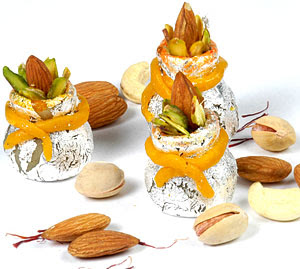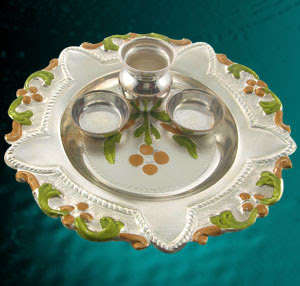Monday, October 27, 2008
Saturday, October 25, 2008
~*~Diwali Pooja Thali Decoration Ideas~*~
Diwali Pooja Thali Decoration Ideas
Velvet Pooja Thali
Steps:
1. Take a plane steel thali.
2. Cover it with a velvet cloth of any color.
3. Keep your pooja material on it.
4. Decorate a diya with golden color and place it on your thali.
5. You will get a adorably stylized velvet pooja thali.
Simple Thali Decoration
Steps:
1. Take a plain thali.
2. Cut seven any colored cloth and cut it in such a way that a spiral of different colors is formed.
3. Decorate more stick mirrors sequences or any thing on it in a pattern.
4. Now place all the 'pooja items on it with placement of 7 diyas on it.
Pooja Thali with Laces
Steps:
1. Take a plastic/steel plate.
2. Cover the plate completely by pasting different colored papers.
3. Decorate the plate with hanging golden laces all around and small mirrors in the corners.
4. Place statues of God Ganesha and Goddess Lakshmi.
Mirror Mosaic Thali
Steps:
1.Take steel plate or a ceramic plate.
2.Take little pieces of mirror of various shapes and make concentric designs of diyas, swastikas with the help of marker.
3. Now paste the mirror pieces over the design by keeping a distance of about 1 mm between each mirror.
4. Leave it for 5-6hours.
5. Make a paste with plaster of paris and fill all the gaps.
6. You will get a stunning mirror mosaic thali.
Simple Thali Decoration
Steps:
1. Take any plate available at home.
2. Take some bright powdered colors.
3. Design a rangoli on the plate.
4. Then take 5 small sized plates.
5. Put it in the bigger plate.
Place a lighted diya on it.
Tissue Cloth Puja Thali
Steps:
1. Take a plain thali.
2. Stick some paper on it.
3. Then take red or any colour tissue cloth. Cut it in a round shape, little big from plate size then piko it. Take golden ghungru and stitch them all around the border of the cloth.
4. Stick the cloth at plate. Then take some stone and stick for decoration. Place a Ganeshji photo and kalash for decoration.
Thali Decorated with Dupatta
Steps:
1. Cover a thali with a bandej duppata or cloth.
2. Stick gota or lace along the dupatta.
3. Stick ghungroos or bells in the 4 corners of dupatta.
4. Place rose petals in corners and now place diya in between.
5. Your thali is ready.
Water Filled Thali
Steps:
1. Make some colourful designs at the border of the thali using color, lace or gota.
2. Fill the thali with water (not too much such that it overflows).
3. Put some rose petals in the thali.
4. Place a diya in the centre of the thali and lit it.
5. Place two small containers for "chawal" and "rolli" to keep it in the water filled thali.
6. Your unique and great Aarti or Puja Thali is ready.
Painted Puja Thali
Steps:
1. Take a plane thali.
2. Make a pattern on it.
3. Now, paint with oil or poster colors.
4. Let it dry.
5. Your colourful Diwali Puja Thali is ready.
Zari Border Puja Thali
Here is a beautiful way to decorate Pooja Thali in a traditional way using the items available at home itself.
Steps:
1. Cut an old zari border of a saree or a duppata and stitch small ghungroos or shells (kauris as found on Gujarati dupattas) on it.
2. Then with the help of fevicol or fevibond paste this on the border of the palte.
3. Take coloured jute thin rope or moli and paste it at the centre of the plate making a spiral shape.
4. The thali will look colourful and traditional.
Thali Decoration with Haldi and Roli
Steps:
1.Take a plain thali.
2. Spread a little oil on the thali.
3. Now place good amount of haldi (turmeric) and roli on the thali.
4. Move the thali in all directions. You will wonder at the way haldi and roli mixes and spread all over the thali and covers it.
5. Now with a match stick make a pattern or design of your choice.
6. Sprinkle glitter on the thali.
7. Place all the items of pooja on the thali and have a glittering Diwali.
Take Plain Diwali Puja Thali. Create a swastik design by sindoor on the pooja thali
Arrange all the essential accessories for diwali pooja, which includes:
diya, candles
roli, chawal, moli ( kalava)
doop, agarbatti, camphor
laxmi ganesh silver coins / idols
a bell
water in a container
coconut
sweets / fruits ( for parshad)
flowers
Your Diwali Thali is Ready for Puja
The beautiful diwali thali contains diya, betel leaves, supari, cardamom, clove, sweets and fruits for each navgraha.
Place all these on the diwali puja thali - agarbathi, camphor, sandalwood powder, a bell, uncooked rice, uncooked milk, gold and silver coins with ganesh and laxmi imprints for prosperity.
Swastik is to be made of sindoor on the thali, kalash and coconut.
Extra sindoor, parshad of sweets - set all these on the thali for aarti.
Can also add dhoop for a more purified prayer.
Take a steel plate and rangoli colors. Decorate your plate with rangoli design and place diya and sweets for God in appropriate place!
Illuminated Thali
Steps:
1. Cover a thali with a bright coloured satin or jacquard cloth.
2. Give thali a border by sticking a contrast colour fancy lace, using glue.
3. Now stick mirrors and kundan stones of different colours and shape tastefully and then arrange the required items on the thali.
4. If the mirrors are stuck around the center, then place a fancy aroma candle in the center. When lit the light will be reflected by the surrounding mirrors and enhance the beauty of the thali.
Paper Sunflower Puja Thali
Steps:
1. Take one yellow crepe paper and cut it in shape of petals.
2. Take another brown shining paper and cut it in a small circle. This will be used to form the centre of the flower.
3. Take a white paper and cut it in a round shape. Stick the brown paper on it using gum. Then stick petals around it to form a sunflower.
4. To give a realistic look to this sunflower on the brown round shape apply gum and put tea powder so that it looks like sunflower bud.
5. Sunflower is ready now.
6. Stick this sunflower on the plate.
Puja Thali Decoration with Kumkum
Steps:
1. Take a small-medium sized steel thali. Put about 2 teaspoons of ghee (clarified butter) in the thali and spread it all over it.
2. Sprinkle some kanku (kumkum) all over the thali.
3. Once it is evenly spread, in the center of the thali draw a swastika with 4 dots or an aum with your finger (you should be able 2 see the steel underneath.)
4. Put down flower petals where you would put the diva (put the diva in the center of the swastika or aum) a bell,camphor, an om symbol and a little rice.
5. Light your diva and have an awesome Diwali.
Silver Paint Puja Thali
Steps:
1. Take a round shaped thali.
2. Sparkle the thali with silver colour.
3. Make any design on thali with red sparkle after the silver paint has dried.
4. Cover the edge of the thali with a golden lace.
5. Place diya in between and two small box covered with lace with kanku and chaawal inside. Also place a small nariyal, mauli and five coins.
Pumpkin Diya Puja Thali
Material Required - Colorful flowers, spoons of different size , white Pumpkin, dough, tack pins, plate
Steps:
1. Cut the pumpkin and make a flat surface so that it can rest on plate. If you want you can stick it with little dough.
2. Cover the spoons with colorful dough & start poking in the pumpkin from upside down small to bigger by size in a circular way.
3. Once you have poked the spoons, in the empty space prick flowers with tack pins so that the pumpkin gets covered.
4. Cover the sides of plate with flowers.
5. Then burn the diyas in the spoon it will form a deep stambh or lit pillar. You can form the deep stambh of 11 or 21 diyas or as many as you wish.
Sunflower Puja Thali
Steps:
1. Take a medium size Thali and colour it with oil paints or poster colours (use golden yellow colour as background) all over the thali.
2. Draw small flowers on the side of the thali (surrounded with flowers)use orange or red colour for flowers. There should not be any gap between flowers.
3. Draw a big sunflower in the center of the thali using lemon yellow. Give little bit of orange as shade in the center of the petals.
4. There will be space left between the side flowers and center flower. Keep some rose petals on this left space (around the sunflower put this rose petals).
5. Keep the diya in the center of the sunflower and light it.
6. Keep some chawal and kumkum in a small container and place it on the rose petals.
Aarti Thali Decoration with Kumkum and Lots of Flowers!!
Material Required - Thali of any material (Steel, Copper, Brass), Ghee, Vibrant flowers(such as red, pink, yellow, white etc.), 5 diyas, Cotton wicks, Bell, Camphor along with the camphor holder.
Steps:
1. Get a steel thali of atleast medium to large size.
2. The thali should be either of steel, copper or brass.
3. Take 2 teaspoons of ghee & spread it gently all over the thali.
4. Sprinkle some Kumkum on the evenly spread ghee thali.
5. Now draw a figure such as a Lotus flower with your finger.
6. Beautify the look further with flowers.
7. Prepare a beautiful garland made either with white or yellow flowers.
8. Fill up the the inside of the figure's with some red or pink flowers.
9. Fill up the outside part of the figure's shape with white and yellow flowers.
10. Leave some space between the figure's shape & thali's border.
11. Make use of either of these puja accessories as abil, gulal, chandan, sindoor or haldi to highlight the inside part of the border.
12. One can even use tulsi leaves or flower petals.
13. For placing of the diyas, make 5 spaces. Diyas should have cotton wicks soaked in ghee.
14. Put the bell and camphor holder in one part of the thali.
15. Highlight the area with vibrant colored flower petals beautifully forming some pattern.
16. Finally, lighten the Diyas which completes the look of the stunning looking Aarti Thali!!!
Have a Rocking Dipawali

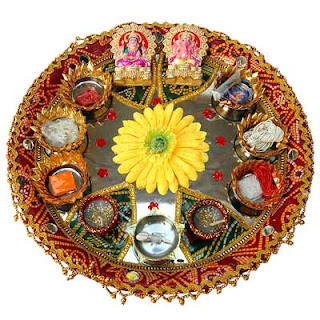

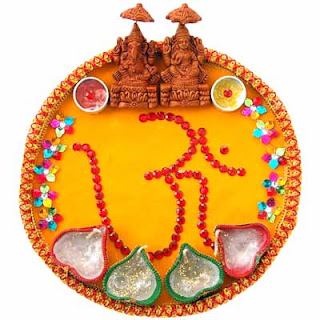

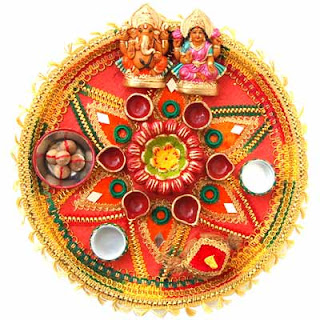

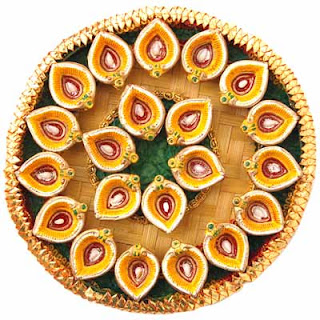
~*~Diwali Diyas~*~
Diwali Diyas
In each legend, myth and story of Deepawali lies the significance of the victory of good over evil; and it is with each Deepawali and the lights that illuminate the homes and hearts, that this simple truth finds new reason and hope. Since baked-mud 'diyas' or 'deeps' are considered more holy and auspicious, they are purchased to light on the Diwali night, particularly before the idols or photographs of gods and goddesses while offering prayers.
A Diya is a small earthen lamp that is lit especially at Diwali. They are usually made of clay. Ghee or oil is used as the fuel and cotton wool as the wick. Sometimes they are made by part filling a glass with colored water, Ghee is floated on top, and again cotton wool used as a wick. Children could make there own Diya with air dried clay or play dough. For safety reason these diyas should not be lit with Ghee and cotton wool.
Beautifully crafted diyas beckon attention of the buyers. The earthen diya used on the occasion of Diwali, reflects ancient design sense that is simple and stunning in concept and universal in appeal. The Diwali season sees a proliferation of clay creativity ranging from roadside agals to designer diyas displayed in art and craft boutiques.
During Diwali, various shops showcases brilliant diyas and lamps crafted by ceramic designers from all over the country. There are also diyas with zari and mirror in exuberant colours. Delightfully, imaginative diyas with sharply cut edges, embellished with cut work are covered and filled with bright coloured wax.
Mirror work and zari embellished deep, traditional diyas as well as those embellished with fragrant dried flowers, Ganesha and Lakshmi diyas with 21 or 11 spouts, diyas shaped like China leaves and shaded roses, tiny Parvati Ganesha lamps and many other design vie for attention. Made out of clay, the diyas in vivid shades of yellow, blue, pink, gold and silver are well crafted.
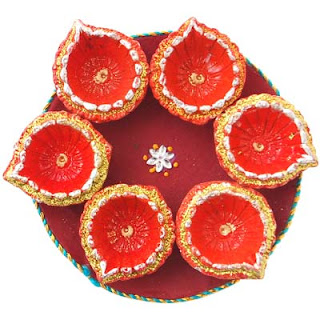
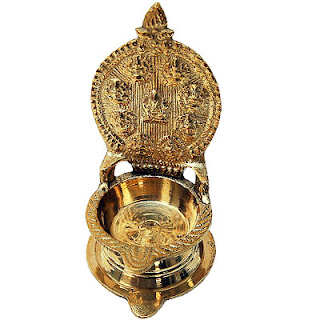

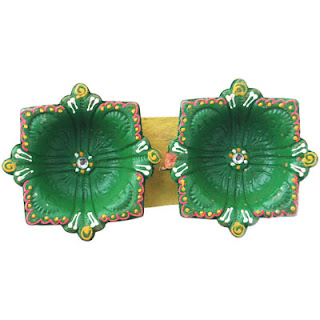
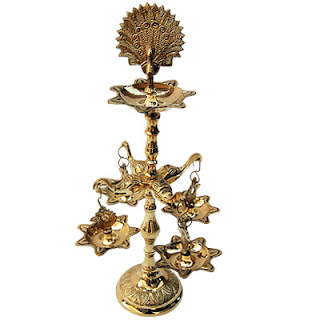
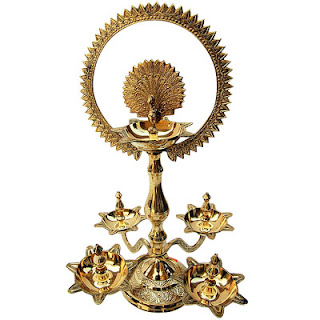


Friday, October 24, 2008
~*~Diwali in History~*~
Diwali in history
The history of Diwali is replete with legends and these legends are moored to the stories of Hindu religious scriptures, mostly the Puranas. Though the central theme of all legends point out to the classic truth of the victory of the good over the evils, the mode of their presentation and the characters differ. Diwali, being the festival of lights, lighting the lamp of knowledge within us means to understand and reflect upon the significant purpose of each of the five days of festivities and to bring those thoughts in to the day to day lives.
The five day of Diwali
The first day of Diwali is called Dhanvantari Triodasi or Dhanwantari Triodasi also called Dhan Theras. The second day of Diwali is called Narak Chaturdasi. It is the fourteenth lunar day (thithi) of the dark forthnight of the month of Kartik and the eve of Diwali. On this day Lord Krishna destroyed the demon Narakasur and made the world free from fear. The third day of Diwali is the actual Diwali. This is the day when worship for Mother Lakshmi is performed. On the fourth day of Diwali, Goverdhan Pooja is performed. The fifth day of the diwali is called Bhratri Dooj. It is a day dedicated to sisters.
Hindu Mythology
The Story of Rama and Sita: Lord Rama was a great warrior King who was exiled by his father Dashratha, the King of Ayodhya, along with his wife Sita and his younger brother Lakshman, on his wife's insistence. Lord Rama returned to his Kingdom Ayodhya after 14 years of exile, in which he put an end to the demon Ravana of Lanka, who was a great Pundit, highly learned but still evil dominated his mind. After this victory of Good over Evil, Rama returned to Ayodhya. In Ayodhya, the people welcomed them by lighting rows of clay lamps. So, it is an occasion in honor of Rama's victory over Ravana; of Truth's victory over Evil.
The Story of King Bali and Vamana Avatar(the Dwarf):
The other story concerns King Bali, who was a generous ruler. But he was also very ambitious. Some of the Gods pleaded Vishnu to check King Bali's power. Vishnu came to earth in the form of a Vamana(dwarf) dressed as priest. The dwarf approached King Bali and said "You are the ruler of the three worlds: the Earth, the world above the skies and the underworld. Would you give me the space that I could cover with three strides?" King Bali laughed. Surely a dwarf could not cover much ground, thought the King, who agreed to dwarf's request. At this point, the dwarf changed into Vishnu and his three strides covered the Earth, the Skies and the whole Universe! King Bali was send to the underworld. As part of Diwali celebrations, some Hindus remember King Bali.
The Defeat of Narkasur by Lord Krishna:
Lord Vishnu in his 8th incarnation as Krishna destroyed the demon Narkasura, who was causing great unhappiness amongst the people of the world. Narkasura was believed to be a demon of filth, covered in dirt. He used to kidnap beautiful young women and force them to live with him. Eventually, their cries for rescue were heard by Vishnu, who came in the form of Krishna. First, Krishna had to fight with a five-headed monster who guarded the demon's home. Narkasura hoped that his death might bring joy to others. Krishna granted his request and the women were freed. For Hindus, this story is a reminder that good can still come out of evil.
Krishna and The Mountain:
In the village of Gokula, many years ago, the people prayed to the God Indra. They believed that Indra sent the rains, which made their crops, grow. But Krishna came along and persuaded the people to worship the mountain Govardhan, because the mountain and the land around it were fertile. This did not please Indra. He sent thunder and torrential rain down on the village. The people cried to Krishna to help. Krishna saved the villagers by lifting the top of the mountain with his finger. The offering of food to God on this day of Diwali is a reminder to Hindus of the importance of food and it is a time for being thankful to God for the bounty of nature.
Sikh Festival Diwali
In Sikh perspective, Diwali is celebrated as the return of the sixth Guru, Guru Hargobind Ji from the captivity of the city, Gwalior. To commemorate his undying love for Sikhism, the towns people lit the way to, Harmandhir Sahib (referred to as the Golden Temple), in his honour.
Jain Festival Diwali
Among the Jain festivals, Diwali is one of the most important one. For on this occasion we celebrate the Nirvana of Lord Mahavira who established the dharma as we follow it. Lord Mahavira was born as Vardhamana on Chaitra Shukla 13th in the Nata clan at Khattiya-kundapura, near Vaishali. He obtained Kevala Gyana on Vishakha Shukla 10 at the Jambhraka village on the banks of Rijukula river at the age of 42.
Friday, October 17, 2008
~*~Karva Chauth~*~
HAPPY KARVA CHAUTH
Karva Chauth is observed by married women (suhagini) for ensuring wedded bliss and wishing long life for their husbands and children. A married woman who observes this vrat is called ‘Saubhagyavati’ (joyous and happy state of wifehood).
On the occasion of this vrat (Fast) a kalash (small container) is filled with either milk or water. In that kalash is placed Pancha Ratna (five pieces of different metals gold, silver, copper, brass and iron). The kalash is then presented to a Brahmin and also exchanged with other married women. While thus presenting the kalash, a wishful prayer is offered to Lord Ganesh: "Let the offerings of this Karva (Karak (gift bring long life to my husband and may my saubhagya be everlasting". And express such desire that ‘May my death precede that of my husband so that I can enter the chitaa (funeral pyre) as a bride (not as a widow).
This katha (narrative) first took place between Siva and parvati. Siva told Parvati about the significance of Karva Vrat. In Dwapar Yuga, Draupadi asked Lord Krishna about the vrat of Karva Chauth. Thereafter, the very first time this vrat was observed in the town of Shukraprastha by Veeravati, the daughter of Vedsharma and Leelavati. Ever since this vrat has been observed by married women till the present day.
On the occasion of Karva Chauth which is on the day of Kartik Krishna Chaturthi, fasting (vrat) is observed. In the evening, after taking a bath, under a banyan tree (or in the absence of such tree, draw a picture of such tree) place murtis or pictures of Siva, Parvati, Ganesh and Kartikeya and do puja ceremony (shodashopachar or sixteen step puja ceremony). Then for the offerings of arghya (rice, flower etc.), while waiting for the moon to rise, japa is done with the mantra "Om namah Shivaya". Havan (sacred fire ceremony) is also done. Thereafter, having sited the moon, offer the arghya.
If the husband is present, then worship him with Panchopchar or gandh, pushpa, dhoop, deep and naivedya (perfume, flower, incence, lamp and food). If the husband is away on travels, then offer a prayer to Almighy to grant long life to your husband. Thereafter bring the vrat to its conclusion.
Lord Krishna urged Draupadi to observe the vrat of Karva Chauth so that through its influence Arjuna can defeat the Kauravas on the battlefield and acquire back the kingdom.
Married women who thus offer wishful prayer for saubhagya by observing the Karva Chauth Vrat, acquire saubhagya, progeny and lasting prosperity.
